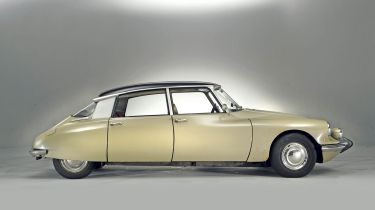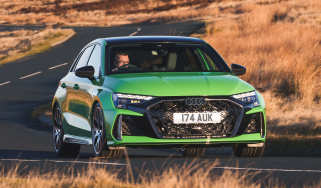Citroen DS
Badge played on French word for goddess – and luxury saloon was certainly out of this world.
If previous Citroens looked as if they had come from the future, the DS appeared to have flown in from another planet. When the stunning saloon made its debut at 1955’s Paris Motor Show, it was dubbed ‘the spaceship on wheels’.
The DS was intended as a replacement for the long-serving Traction Avant, and was so incredibly advanced, it made the competition look obsolete. Under the jaw-dropping aerodynamic bodywork, it pioneered the company’s trademark hydro-pneumatic suspension system.
Styled by Italian designer Flaminio Bertoni, the DS still looks remarkably fresh today – as the 1967 model in our pictures shows. Neat detailing includes the eye-catching, trumpet-shaped housings for the roof-mounted rear indicators. A minor facelift in 1968 introduced directional headlamps that turned with the steered wheels to follow the road ahead, although the rest of the exterior remained virtually unchanged during 20 years of production.
Marking out this Citroen as something special, though, was what lay beneath those bold lines. Design genius André Lefebvre used high-pressure hydraulics for the fully independent self-levelling suspension, as well as power-steering, disc brakes and a semi-automatic gearshift.
On the road, stability was excellent and the ride supremely comfortable. What’s more, owners could change a tyre without using a jack, or even run the car on three wheels! The cabin was equally forward thinking. Occupants got soft, sofa-like seats, while the thin windscreen pillars and wraparound screen gave excellent visibility. Other features included Citroen’s trademark single-spoke steering wheel.
Even today, the DS is simply out of this world to drive. Fire up the engine and the car rises gracefully. To select a gear, you flick a small wand-like lever
on top of the steering column, and the hydraulics take care of the rest.
On the move, the suspension filters out bumps in the road, endowing the car with Citroen’s famous ‘magic carpet’ ride. Stopping demands concentration, though, because in place of a traditional brake pedal you get what looks like a small rubber mushroom. This sensitive device requires a delicate touch if you want to slow down smoothly. Apply the sort of pressure required to halt a normal car, and the powerful brakes are liable to pitch you through the windscreen.
Spoiling the experience slightly is the rough and underpowered 1.9-litre engine. From the start, the DS was meant to have a flat-six-cylinder, but development of this was abandoned due to rising costs. Instead, Citroen made do with powerplants that had started life in the Traction Avant.
Later versions benefited from larger 2.0, 2.1 and fuel-injected 2.3-litre units, although these still didn’t do justice to the advanced chassis. Not even this can detract from the model’s legendary status, however. Few cars before or since have made such an impact as the DS.



